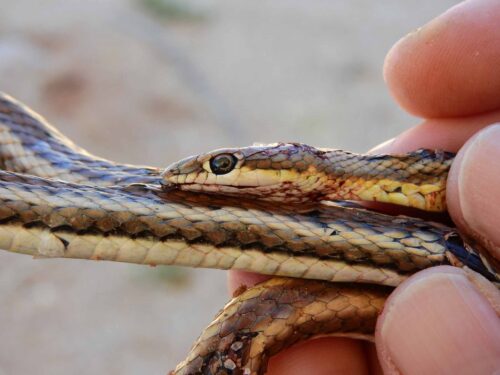Love them or fear them, snakes fascinate people. Given their popularity, you’d think a class working on snake biodiversity would find few opportunities to create new species articles. So I was surprised when student editors in Andrew Durso’s Snake Biodiversity class at Florida Gulf Coast University created eight new articles about snake species as part of their Wikipedia assignments last term.
Species articles can be good places for student editors to make contributions. They tend to follow a fairly constant template, and there are a lot of species whose articles don’t exist, or are very short stubs. But much like they are in the real world, mammals and birds tend to be the best documented groups of living things on Wikipedia.
Most of the snake species that the students in this class worked on have restricted geographical ranges (one species is only found on two small islands in Japan), or are shy species that generally avoid humans. They aren’t well known, even by scientists, and what little is known about them is likely to be in journal articles behind paywalls.
“Digging basic natural history information out of books and older journals, putting it together and making it accessible takes a lot of time to do well,” Dr. Durso reflected. “Training young people to do this should help them think more critically about where information comes from.”
Unless someone writes a Wikipedia article about them, the odds of the average person hearing about them is low. Resources for conservation are always limited, so the more obscure the species, the less likely it is that anyone’s collecting the data you’d need to help ensure their survival.
Prosymna is a genus of snakes that live in sub-Saharan Africa. It’s the only genus in the family Prosymnidae, and there are 19 known species in the genus. But prior to the contributions by Durso’s class, all that Wikipedia had to say about this entire snake family was a single article with four sentences and a list of the 19 species.
Now, thanks to student editors in this class, there are also articles about two of these species:
Prosymna frontalis is found in rocky areas in South Africa, Namibia, and possibly Angola, while Prosymna angolensis lives in savannas and miombo woodlands in Angola, Botswana, Namibia, Zambia and Zimbabwe. Both of these snakes are rarely encountered in the wild, and little is known about their conservation status.

Prosymna wasn’t the only group of snakes who benefited from this class’s work.
Students also created articles about four other African snakes. Two of them are from the mainland–Psammophis trigrammus, which ranges from Namibia into northern South Africa, and Psammophylax multisquamis ranges from Tanzania to Ethiopia. The other two–Langaha pseudoalluaudi and Ithycyphus goudoti–are from Madagascar.
And rounding things off were newly-created articles about Asian snakes. Sinomicrurus iwasakii is an Asian coral snake found only on two islands in the Ryukyu Archipelago, while Sinomicrurus annularis lives in northeastern Vietnam and southeastern China.
In addition to creating these eight articles, students in the class signficiantly expanded another 28 articles about snakes including Leioheterodon modestus, which is endemic to Madagascar, Philodryas aestiva, which comes from Brazil, and Phyllorhynchus decurtatus, which lives in the United States and Mexico. Many of these 28 articles were just single-sentence stubs before Durso’s students came along and transformed them into multi-paragraph texts.
While writing a Wikipedia article can be demanding for students, it’s also a rewarding and meaningful assignment. “Writing a Wikipedia article was overall a super fun experience and so different from any assignment I’ve had before,” said a student in Durso’s class.
Whether they’re adding missing information to existing articles or creating new ones, student editors can contribute important information to Wikipedia that might otherwise never get added. Thanks to the work of this class, 38 snake species are better documented in the only place most people are ever going to look for them: Wikipedia.
Our support for STEM classes like Andrew Durso’s is available thanks to the Guru Krupa Foundation.
Interested in incorporating a Wikipedia assignment into your course? Visit teach.wikiedu.org to learn more about the free resources, digital tools, and staff support that Wiki Education offers to postsecondary instructors in the United States and Canada.
